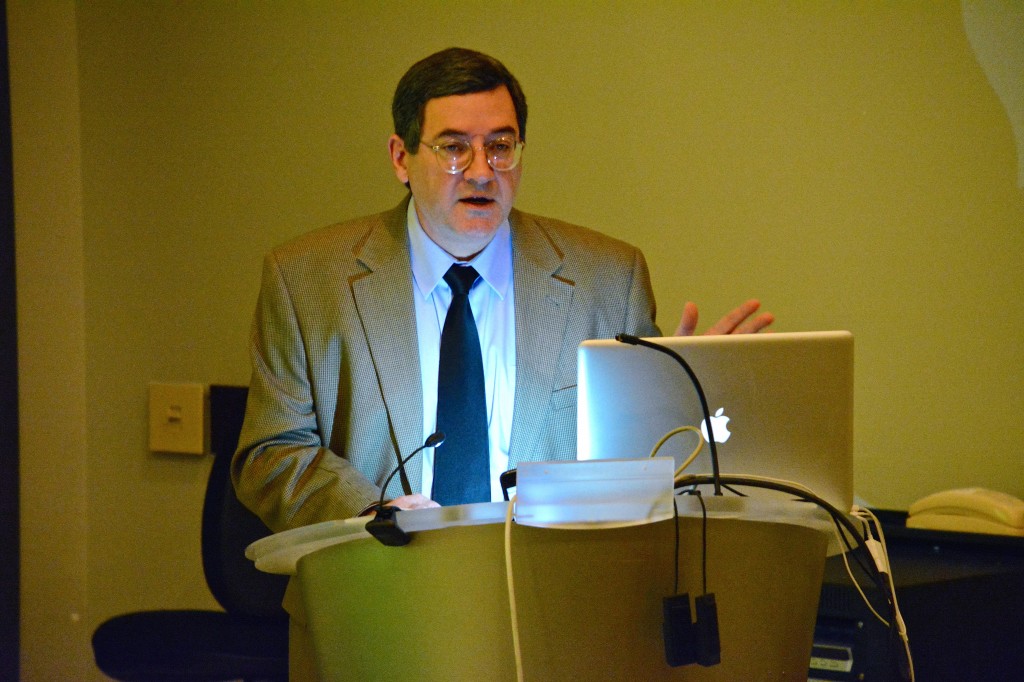
Saturday afternoon, faculty and students gathered in the Fine Arts Building to learn how to catch an art forger.
Four art experts discussed the history of art forgery and how to differentiate between an authentic work of art and a fake. William Voelkle, curator at the Morgan Library & Museum in New York City and a member of Binghamton University’s class of 1961, focused on the Spanish Forger, a famous unidentified master forger who worked from the late 1800s to early 1900s. Because of his fame, the forgeries themselves became both popular and valuable.
“There were two auction houses each selling work by the Spanish Forger,” Voelkle said. “One was being sold as a genuine 15th-century piece, the other one was being sold as by the Spanish Forger. Which one do you think got more? The Spanish Forger.”
The potential for making hundreds of thousands of dollars is what drives these forgers, according to Patrick McGrady, curator of the Palmer Museum of Art at Penn State University and BU alumnus from the class of 1992. He said the sheer mass of fake artwork is enormous.
“The fakes out there on the market actually exceeded the number of legitimate works for sale,” McGrady said. “Think for just a moment what this means. You’re in the market for just the right Nina Kogan to hang over your sofa in the living room. Chances are better than 50/50 that you’ll be going home with a fake.”
McGrady said that a major strategy for forgers is to create copies of lesser known artists.
“The smarter ones do that, and it takes longer to catch them,” McGrady said. “Your longevity is almost guaranteed by going at that lower tier and still being diligent in your forgery. They do second tier and third tier artists all the time.”
These attempts at imitation often require a lot of work, according to Betty Krulik, an art appraiser. Krulik discussed the techniques forgers use in order to make their art look authentic, such as making the work look older than it really is. This could include faking the cracking that naturally occurs on materials due to temperature changes, and using tea staining on paper in an attempt to imitate actual aging.
Experts often test the paintings for certain types of pigments, like those used by Spanish Forger. A lot of forgers will use pigments that are too modern to have existed during the period the original painter was alive, like arsenic and titanium white, which was only available after 1920. Sometimes forgers will also attempt to make a canvas look aged, but the area underneath the canvas’s stretcher will be too white.
This event was sponsored by the Kenneth C. Lindsay Study Room Fund, which had originally been used to create the study gallery in honor of Lindsay’s passing, but had extra money left from the gallery renovation process. Lindsay was an art history professor and taught a class that focused on fakes and forgeries.
“We had more money and were able to do this program with that money on a topic that was close to his heart,” said Diane Butler, director of the BU Art Museum. “We do have a couple pieces in our education collection that we know are fakes. They are very useful for comparing to another one that is authentic.”
Lynn Schmidt, a first-year graduate student studying organic chemistry, was drawn to the event because of her undergraduate minor in medieval studies.
“I wanted to see exactly how they were able to detect the forgeries,” Schmidt said. “I knew the science of it. I didn’t know the full extent economically, I could never imagine the potentially billion dollar industry that it was.”


